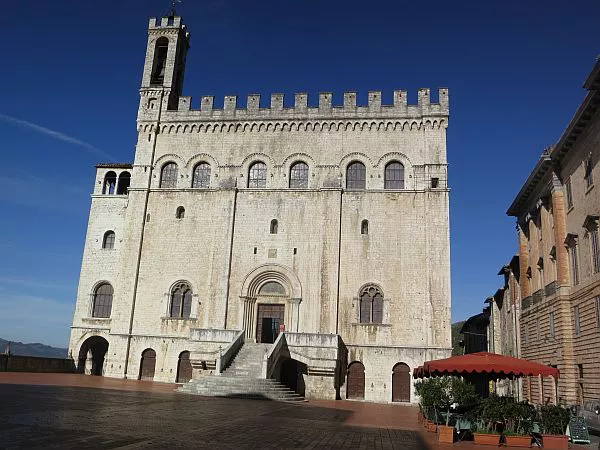Gubbio is a well-preserved medieval hill town located in the Umbria region of central Italy. The compact center features a remarkable selection of medieval, Gothic, and Renaissance monuments crafted from gray limestone, affording stunning views over the picturesque countryside. Just outside the town, visitors can explore a Roman amphitheater.
Location
Gubbio is situated in Umbria, approximately twenty-five miles northeast of Perugia and about 40 miles south of Urbino in the adjacent Marche region. The town is beautifully perched on the lower slopes of Mt. Ingino, making it a scenic destination.
Transportation
The nearest train station is Fossato di Vico, which is located about 12 miles away. Buses connect Gubbio with this station as well as other nearby towns. For those driving, the scenic SS298 road between Perugia and Gubbio offers beautiful views. Additionally, Umbria includes a small airport at Perugia that accommodates flights from Europe and the UK. Gubbio is approximately 124 miles from Rome Fiumicino airport.
Where to Stay
Consider Hotel Relais Ducale, set in a 14th-century mansion right in the historic center, boasting stunning valley views. Another option is Hotel Busone, a cozy 4-star hotel also located in the historic area. For a unique experience, Park Hotel ai Cappuccini is a 4-star hotel housed in a former monastery, just two miles from the city center. For a complete medieval experience, don’t miss Castello di Petroia, a castle hotel near Gubbio.
Festivals
Gubbio is home to one of Italy’s most impressive festivals, held annually in May. The Corsa dei Ceri, celebrated on May 15, begins with a grand procession through the streets leading up to the Abbey of Sant’ Ubaldo. The event includes a spirited race featuring teams carrying towering candle-shaped pillars, each weighing 200 kg and adorned with statues of St. Ubaldo, St. George, or St. Anthony. The last Sunday in May marks the Palio della Balestra, a traditional crossbow competition that pits the archers of Gubbio against those from nearby Sansepolcro, a tradition that dates back to at least the 15th century.
Shopping
Known for its exquisite ceramics, Gubbio features numerous shops selling hand-painted ceramic items, particularly along Via dei Consoli. Other notable handicrafts include wrought ironwork and lace. Visitors can enjoy market day every Tuesday, which offers a variety of local goods.
Top Sights
- Roman Theater: This historical site, dating back to the 1st century AD, hosts open-air performances during summer. The amphitheater offers fantastic views of Gubbio, making it an ideal starting point for your visit.
- Church of San Francesco: Located in the lower town, this Gothic church features an impressive rose window and a collection of frescoes dating back to the 1200s. The church is situated on the vibrant Piazza Quaranta Martiri, where buses arrive.
- Piazza Grande: Gubbio’s main square provides breathtaking views over the surrounding countryside and is easily accessible from Via Piccardi.
- Palazzo dei Consoli: This monumental 14th-century Gothic building houses an art gallery and archaeological museum, showcasing the Eugubine tablets, bronze plaques written in the ancient Umbrian language.
- The Duomo: A 13th-century church with a simple yet elegant façade, featuring notable stained glass windows and a Roman sarcophagus as its high altar.
- Palazzo Ducale: Constructed for the Duke of Urbino in 1476, this palazzo has a charming Renaissance courtyard and is open for public visits.
- Porte del Morto: This feature can still be seen in several older homes; buildings often had two doorways to facilitate the removal of the deceased.
- The Bargello: Constructed in 1302, it was the first public building in Gubbio. Nearby, visitors can find the 16th-century Fonatna dei Matti, the town’s historical water source, nestled in a picturesque medieval quarter.
- Ranghiasci-Brancaleoni Park: Located beneath the Palazzo Ducale, this park originated as an English garden in 1841 and features beautiful landscapes including a cafe.
- Porta Romana: This museum at the east end of town showcases a collection related to medieval gates and includes two 13th-century churches nearby.
- Abbey of Sant’ Ubaldo: Accessible by funicular, the abbey offers stunning views and includes a cafe and restaurant.
- The Rocca: Positioned above the abbey, this location provides breathtaking panoramic views for visitors.





